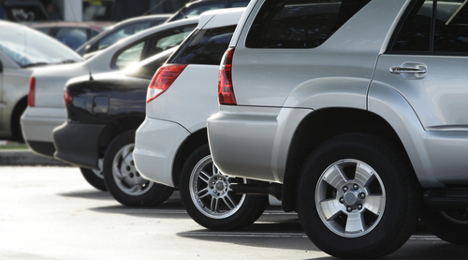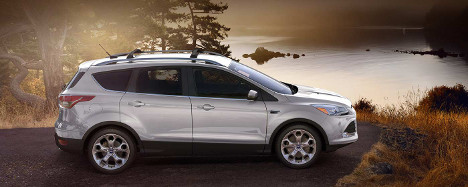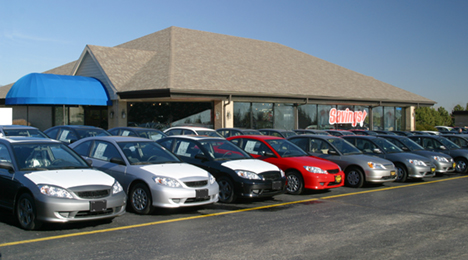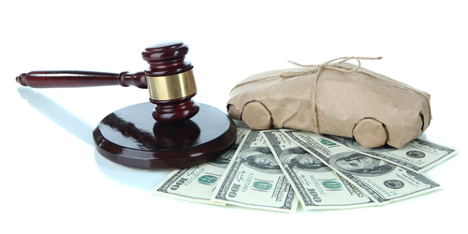Prices in the lanes for prime used vehicles saw depreciation slow even further in August.
According to the latest Blue Book Market Report from Kelley Blue Book, prices for 1- to 3-year-old used vehicles held their values better last month than movement seen earlier this summer.
The average vehicle value to younger used vehicles declined by 1.4 percent or $250 in August, according to the report. This is a significantly better performance than movement seen in June and July, when prices dropped by 2.6 percent and 2.2 percent, respectively.
Once again the pickup truck segments out-performed the smaller segments. According to KBB data, prices for midsize pickup trucks rose by 0.5 percent last month for the biggest price hike of all segments. Next up was the full-size pickup trucks, which saw prices rise by 0.4 percent.
“It’s no surprise that the pickup truck segments remain the top performing segments this month, as they have been some of the best performing segments since the start of the year,” said Sean Foyil, KBB analyst. “Despite a mere 1.5-percent increase in total construction spending between May and June, from a year-over-year perspective, construction spending is up roughly 12 percent, which greatly benefits the truck segments.”
Interestingly, the only other segment to see prices rise last month was seen among the hybrid/alternative energy car segment, which has seen massive depreciation over the past year. This segment saw prices rise by 0.2 percent in August.
As the summer months come to an end, it seems consumer interest may be shifting away from the sportier segments.
According to the report, the sports car, high-end luxury and high-performance car segments were the worst performing segments last month.
Sport cars saw the biggest price drop, with a decline of 3.3 percent, followed by the high-end luxury segment, which saw prices slide by 3.2 percent. The high-performance car segment saw a decline of 2.9 percent in the lanes in August.
The KBB report also took a look at the top performing models at auction over the past four weeks. Coming in at No. 1 is the Fiat 500L, which has seen prices rise by 4.7 percent over the past four weeks. This model was followed by the Chevrolet Silverado 1500 Double Cab, which has seen prices rise by 3.1 percent over the same period.
Another pickup truck came in at No. 3 — the GMC Sierra 1500 Double Cap — with a price spike of 3 percent. Rounding out the top five were the Infiniti QX70 (up 2.9 percent) and the Nissan Frontier King Cab (up 2.6 percent).
Black Book also reported on August price movement at auction last week. According to Black Book data, though pickup truck values remained strong in August, crossovers were the outlier last month with prices dropping more rapidly for most of these segments.
For example, compact pickups saw rates rise by 0.4 percent in August, according to Black Book, while full-size crossovers saw the highest depreciation out of all segments with prices dropping by 3 percent to an average price of $18,650 for August. This marks a 15.4 percent year-over-year drop for full-size CUVs.
The effects of increased supply are starting to become more evident in the wholesale market.
Commenting on the first year-over-year decline in used-car prices in a year, ADESA’s Tom Kontos said in his latest Kontos Kommentary report: “We now see a clearer picture of the downward pressure that supply growth is putting on prices.”
The picture for August was this: average wholesale prices were off 0.2 percent at $9,575.
This marks the first year-over-year dip since last August, Kontos said in the report recapping ADESA Analytical Services' monthly analysis of wholesale values.
Pricier, late-model off-rental program vehicle sales have slowed down from once-high levels, Kontos added. So that means the year-over-year comparison, at least when it comes to the makeup of seller types, can be viewed with “more of an apples-to-apples” lens.
Offering its take on auction volume, Kelley Blue Book analysts point out in a recent report that auction lane volume jumped 5 percent (or, put another way, more than 23,000 units) on a month-over-month basis in July.
KBB also mentions in the Blue Book Market Report that there has been a steady uptick in auction volume since June.
“In August, Kelley Blue Book field analysts reported seeing approximately a 25- to 30-percent decrease in auction volumes for General Motor vehicles as well as German manufacturers BMW and Mercedes-Benz,” KBB says in the report.
“The decrease in the volumes for these manufactures likely is due to the holding of inventory in an effort to not oversaturate the market with vehicles in an effort to maintain vehicle value levels,” analysts added. “Conversely, field analysts have reported a spike in Land Rover vehicles throughout the auction lanes this past month, which may be linked to an oversupply in inventory of particular models at the moment.”
According to the most recently updated Economic Dashboard from the National Auto Auction Association, auction volume was up 7.7 percent in July (against comparable weeks of 2014), with the year-to-date increase at 7.4 percent.
Impact of incentives on price
Going to back to his monthly report, Kontos also touches on another factor that has worked in conjunction with increased supply to help drive down price: “Moreover, though retail used-vehicle demand has been strong, average new-car incentives have been climbing, which puts further downward pressure on used-vehicle prices. These impacts are most evident in car prices, as truck prices have held up well in the current low fuel price environment.”
Case in point, truck prices were up 9.8 percent year-over-year in August and car prices were down 5.2 percent. Crossover prices were down 5.1 percent.
The fall selling season is approaching, and depreciation trends are slowing as we leave the summer months behind.
According to the latest Black Book Market Insights report, car prices fell by just 0.37 percent or $42 last week, while trucks saw a slight 0.13 percent or $21 decline.
"Depreciation slowed last week as compact and entry level cars took a breather and most truck segments held their value,” said Anil Goyal, vice president of automotive valuation and analytics.
Black Book editors pointed out a variety of vehicle segment saw a “mild change” from their previous depreciation patterns.
For example, depreciation for compact and entry level cars finally slowed. Entry level cars saw a drop of 0.25 percent or $16, while compact cars droped by just 0.10 percent or $8, bucking strong price decline trends seen throughout the summer for these segments.
Luxury level cars also performed better, showing their smallest price decline in nearly six months. This segment saw a 0.18 percent or $36 drop last week in the lanes.
On the other hand, full-size cars didn’t perform quite as well, dropping by a significant 0.87 percent or $80.
Moving over to highlight the truck segments, which continue to perform well at auction, Black Book pointed out depreciation for compact pickups and full-size SUVs along with their weekly adjustments have been less than the overall truck segment average for six consecutive weeks now.
Compact pickups saw prices drop by just 0.06 percent or $8, while full-size SUVs impressed with prices only down by $1.
Depreciation is slowing as we approach fall, but prices were still on the way down in August.
Overall, according to Black Book data, the average price of a used vehicle for model years 2010-2014 fell by 1.6 percent in August, a slightly larger decline than the 1.3-percent drop seen in July.
Though pickup truck values remained strong in August, crossovers were the outlier last month with prices dropping more rapidly for most of these segments.
For example, compact pickups saw rates rise by 0.4 percent in August, while full-size crossovers saw the highest depreciation out of all segments with prices dropping by 3 percent to an average price of $18,650 for August. This marks a 15.4 percent year-over-year drop for full-size CUVs.
Overall, according to Black Book data, the average price of a used vehicle for model years 2010-2014 fell by 1.6 percent in August, a slightly larger decline than the 1.3-percent drop seen in July.
Domestic cars saw prices fall the most with a 2.2 percent decline from July rates, followed by domestic trucks with a 1.3-percent drop. Both import trucks and import cars saw average declines of 1.2 percent.
Despite the significant price drop for crossovers, compact pickups and full-size SUVs bucked the trend and actually saw prices increase last month. And the top 12 vehicle segments with the lowest depreciation during August were all trucks, Black Book editors pointed out.
Compact pickups were up 4 percent, as aforementioned, to finish off the month with an average price of $19,524 in the auction lanes. This marks a 3.1-percent fall off year-over-year.
For full-size SUVs, the segment saw prices rise by 0.2 percent for an average price of $26,670 in August, down 5 percent year-over-year.
“While trucks overall have continued to show great strength for depreciation patterns, it will be interesting to see the trends in the fourth quarter,” said Anil Goyal, vice president of automotive valuation and analytics for Black Book. “The newly designated subcompact crossover segment has also continued to fare well mostly because consumers enjoy the combination of size and features.”
Last month, the subcompact CUVs saw prices fall by 1.2 percent last month for an average price of $18,445 — a segment Black Book will be keeping a close eye on as it gains popularity among consumers.
As for the car segments, the premium sporty cars were the best-performing units last month. This segment saw prices drop by 1.7 percent to an average of $43,684. Interestingly, as supply expands, pushing prices down, this number equates to a 14.7-percent decline year-over-year.
On the other hand, some of the worst performers among the cars in the lanes last month were the prestige luxury cars, which saw prices drop by 2.5 percent and the entry level cars with a decline of 2.4 percent.
Both the sporty cars and entry mid-size cars saw prices drop by 2.3 percent, while the upper mid-size cars and near luxury cars dropped by 2.1 percent.
The compact car and luxury car segments also continue to see prices drop at a more rapid rate, both experiencing 1.9-percent declines in the lanes last month.
Taking these numbers into account, Black Book expects total 2015 depreciation to come in close to 14 percent.
Manheim also offered its analysis on August wholesale prices, noting strong pickup prices are keeping prices at auction higher.
“Pickups, SUVs, CUVs and vans continued to have higher prices year-over-year. Midsize and luxury cars were also up, but the comparison was against weak year-ago pricing,” Cox Automotive chief economist Tom Webb said in his commentary included with the latest Manheim Used Vehicle Index update. “Compact car prices are down 6.7 percent over the past year."
Fueled by a double-digit jump in pickup prices, Manheim noticed wholesale prices (on a mix-, mileage- and seasonally adjusted basis) increased for the third consecutive month in August.
As a result of five of the six major vehicle segments moving higher, the Manheim Used Vehicle Value Index moved up to a reading of 124.3, representing an increase of 2.1 percent from a year ago.
Drilling deeper into the August data showed a 10.1-percent lift in pickup prices, followed not far behind by prices for vans, which shot up by 6.7 percent year-over-year.
The other three segments to tick higher last months included CUVs and SUVs (up 2.4 percent), midsize cars (up 1.9 percent), and luxury cars (up 0.1 percent).
Perhaps the overall price increase might have been higher had it not been for the softening of compact car prices, which declined by 6.7 percent from a year earlier.
“Pickups, SUVs, CUVs and vans continued to have higher prices year-over-year. Midsize and luxury cars were also up, but the comparison was against weak year-ago pricing,” Cox Automotive chief economist Tom Webb said in his commentary included with the latest index update. “Compact car prices are down 6.7 percent over the past year.
“A straight average of auction pricing was up year-over-year for both commercially consigned and dealer-consigned units. The average mileage on dealer-consigned units continued to track slightly below its year-ago level,” he continued.
After touching on the specific vehicle segments, Webb offered some color on how wholesale price movements fit in with other economic developments happening in the U.S. and elsewhere.
“The stability of wholesale pricing, in the face of rising volumes, stands in stark — and welcome — contrast to the volatility in financial markets. It should not, however, come as a surprise,” Webb said. “The reverberations of international events will not be felt in the used-vehicle market unless and until actual fissures develop in our domestic economy.
“Such a reversal of fortune is a definite possibility, but it would likely require an additional buffering by those outside forces as well as policy mistakes on our part,” he added.
Rental risk pricing update
Manheim noticed a straight average of auction prices for rental risk units bumped up from July’s low, but remained below 2013 and 2014 levels.
Webb also pointed out the average mileage on rental risk units fell to its lowest level since October of last year. He said auction volumes were down in August after being up “significantly” in the first seven months of the year.
In August, Manheim said, new-vehicle sales into rental fleets declined 3 percent, but were still up 5 percent year-to-date.
More details about the volume-price relationship
Webb acknowledged that higher wholesale volumes naturally drive prices lower with all other potential factors being equal.
“And, naturally, all other things are never equal,” Webb said. “As evidence, note that a simple regression of adjusted prices as a function of wholesale volume returns no statistically significant results.
“Adding in additional explanatory variables to capture labor market and credit conditions gives the volume variable a statistically significant negative coefficient; but it is not particularly strong, and the residual errors in the equations remain large,” he continued.
Examination of credit impact
Webb explained one of the problems in developing statistical models of future pricing is the difficulty of quantifying the availability of credit, as opposed to its cost.
“And clearly, availability is the more important of the two,” Webb said.
In past cycles, Webb indicated credit spreads could sometimes be used as a rough proxy for availability.
“But our protracted period of near-zero interest rates has left the yield curve devoid of any historical perspective,” Webb said. “Note, for example, that the percentage point spread between the 10-year and two-year Treasury note (monthly average) has been at least 125 basis points since January 2008.
“The spread reached half-century highs during the recovery and even now stands around 150 basis points. Even when the Fed begins it rate hikes, the spread will remain elevated — it may even widen,” he continued. “Chances of an inverted yield curve providing a heads up to the next recession? Slim.”
Final thoughts
Webb closed his latest index commentary but maintaining the market is approaching the time of the season for prices to fall. “Statistically speaking,” Webb reiterated the largest seasonal decline in mix- and mileage-adjusted prices occurs between September and November.
“Over the past decade, the seasonal impact has averaged an additional percentage point of depreciation in each of the three months,” he said. “This year, along with the international issues (which will likely remain turbulent), our budget and debt ceiling ‘debates’ will add uncertainty to the market.”
As vehicle quality and durability has increased over the years, a recent study shows these factors and more are leading to stronger used-vehicle prices.
The latest report from the Used Car Guide division of J.D. Power focuses on how improving quality is having an impact on how new cars are bought and sold as used vehicles, breaking it down into four key areas, one of which is the fact that used vehicles are assuming a more prominent role at franchised dealerships.
The white paper, titled, “Lasting Longer: How Better Quality is Affecting Used Vehicle Demand,” also shows as OEMs continue to ramp up quality, prices are rising in dealership’s used departments.
Increasing quality is causing used vehicles to depreciate at a much slower rate, according to insights from a NADA Used Car Guide Used Vehicle Price Forecast, causing many drivers to hold onto their vehicles longer.
For example, in 1996, the report stated it took about 12 years for vehicle depreciation to stabilize. But over the past two decades, the average vehicle age has grown to 15.3 years, marking a 29 percent increase.
Recent retail analysis echoes this trend, as a recent Edmunds.com report showed used retail prices hit a record high in the second quarter. Aided in part by certified pre-owned units, Edmunds’ analysis showed retail prices came in at an average of $18,800 in Q2, up 7.6 percent — or $1,300 per vehicle — from the second quarter of 2014.
Since improving quality has a played a role in ramping up demand for used vehicles, consequently, prices have gone up, as well. The Used Car Guide white paper stated it came to this conclusion using NADA Used Car Guide’s Used Vehicle Price Forecast model, which measures the relationship between used prices and key influencing factors.
Normally, vehicles depreciate at a constant rate up to a point, or what the report coined as the “depreciation boundary,” which it stated means the vehicle is beyond the age where it will post any meaningful depreciation in price.
That said, taking a look at wholesale transactions, NADA Used Car Guide reached two conclusions regarding this “depreciation boundary.”
First, the depreciation boundary is normally reached when prices to stabilize in the $1,000 to $5,000 range. The catch is with improving quality, it is taking much longer for vehicles to reach this point.
Take these statistics into account. Back in 1996, the average age of vehicles reaching the depreciation boundary was just under 12 years. But over the past two decades, average vehicle age has grown by 29 percent to 15.3 years.
“Because the time it takes to reach the boundary point depends on how fast vehicle values fall, the increase in age is a direct result of slowing used vehicle depreciation,” the report stated.
These numbers from the white paper illustrate the trend further:
- In the late 1990s, used vehicles lost an average of 15.9 percent to 16.5 percent of their value per year.
- Currently, average depreciation has slowed to an annual rate between 14.8 percent and 15.4 percent per year.
The white paper pointed out though this might seem like a small improvement, it can be significant when taken into account over the whole lifespan of a vehicle.
The report offered this example: Compared to the late 1990s, a $25,000 vehicle today would retain $466 more of its value over two years and almost $720 more after six years, due to slowing depreciation.
Another factor that can be taken into account when studying today’s stronger used prices is the narrowing gap between younger and older model prices.
Back in 2004, 4- to 6-year-old model rates were 54 percent as much as prices of models up to 3 years in age, according to the report. By 2014, that ratio had spiked by 15 percent to a total of 69 percent.
“The improvements in older model prices would not have been possible without better vehicle quality,” the report stated. “While we fully expect used-vehicle prices to drift lower over the next few years as supply finally returns to pre-recession levels, the boost in demand stemming from improved durability will keep prices higher than they would have been otherwise.”
Auto Remarketing will recap the two other areas highlighted by the white paper in upcoming editions:
- Vehicle ownership terms are increasing
- Consumers are more open to buying used vehicles
As we head into the last weeks of summer, auction price movement is all over the board with wide variation among segments.
But according to the latest Black Book Market Insights report, remarketing activity has continued a “steady pace” as the season winds down.
In fact, Black Book editors heard many dealers last week talking about the steady flow of sales in the lanes, especially for trucks.
For example, Black Book overheard a buyer from California say in the lanes last week that there was a “very strong sales performance with few no-sales (at a sale last week).”
That said, compact cars continue to see prices suffer as gas prices dropped to an average of $2.64 last week.
Overall, prices for the car segments fell by 0.39 percent or $45 last week, which is just slightly lower than the depreciation rates seen over the past month.
Trucks, on the other hand, held values a bit better last week, with rates only dropping by 0.24 percent or $38. Though still low, this drop for the trucks is a bit higher than depreciation rates seen over the past month.
“Market trends continue to show large declines for compact cars while full-size pickups and SUVs hold their values. Full size vans have now started to drop in value after defying gravity for several months,” said Anil Goyal, vice president of automotive valuation and analytics.
Among the cars, only one segment saw prices rise last week. Entry midsize cars saw prices rise by 0.13 percent or $12, while all other car segments dropped in price.
Compact cars and luxury level cars took the biggest hits. Compact cars dropped in price by 0.78 percent or $63, while luxury level cars also saw prices drop by 0.78 percent or $156.
Other poor performers were the premium sporty cars with a decline of 0.43 percent or $166, and the sporty car segment, which saw prices drop by 0.50 percent or $79, perhaps a sign of approaching colder weather and consequent shift in consumer interest.
On the truck side of the market, full-size vans have been one of the strongest performing segments in recent months, according to Black Book data, but that wasn’t the case this past week.
Full-size vans saw the highest depreciation rate among trucks this past week. The full-size passenger vans saw rates drop by 0.90 percent or $129, while full-size cargo vans declined by 0.79 percent or $109.
Prices stayed flat for compact pickups and luxury level SUVs — the best performing truck segments last week. Other strong runners were the compact CUV and minivan passenger segment, which both saw prices only drop by 0.18 percent or $21.
With their values down 10.5 percent, entry-level cars have shown the most depreciation of any segment since the beginning of May, according to Black Book. And last week, that downhill movement only continued.
So, given how the supply of off-lease and rental cars is ramping up at auctions — which could potentially drive these prices down further — these soft entry-level car prices are worth monitoring, Black Book says.
Entry-level car values were off 0.93 percent ($61) last week, the company noted, meaning this segment was the biggest decliner among the 24 that Black Book tracks.
“The entry-level car segment continues to drop lower even after experiencing the most depreciation in the last four months,” Anil Goyal, vice president of automotive valuation and analytics, said in Black Book’s latest Used Car Market Insights report.
“It will be interesting to see trends on late-model vehicles as more off-lease and rental cars are beginning to show up at auctions,” he added.
For instance, take this comment Black Book personnel gathered from a Texas man in the lanes last week: “More and more rental cars are showing up in this area. We should see what impact this has over the next few weeks.”
Along with listing the top 10 states where used sales climbed most during the second quarter, the latest Used Vehicle Market Report compiled by Edmunds.com indicated that the average used-vehicle retail prices hit a record high in the second quarter.
Aided in part by certified pre-owned units, Edmunds' analysis showed retail prices came in at $18,800 in Q2, up 7.6 percent — or $1,300 per vehicle — from the second quarter of 2014.
Meanwhile, the average age of used cars sold in Q2 2015 was 4.5 years, down from an average of 4.9 years the same time last year.
While used-car managers might think the retail price record might stem solely from the CPO market because of a richer volume of younger, well-equipped units, Edmunds also highlighted in the report how the retail prices for some of the oldest vehicles potentially in dealer inventory are rising sharply. Take a look at what Edmunds uncovered when looking at the year-over-year rise for vehicles from the 2007 model-year and earlier:
— 8 years old: 11 percent
— 9 years old: 13 percent
— 10 years old: 11 percent
— 11 years old: 30 percent
— 12 years old: 30 percent
— 13 years old: 36 percent
— 14 years old: 48 percent
— 15 years old: 55 percent
“There is definitely a lot of demand for vehicles more than 10 years old,” Edmunds.com director of industry analysis Jessica Caldwell told Auto Remarketing during a phone conversation on Friday.
“They’re now at price points for people who just need that mode of transportation,” Caldwell continued. “They’re not looking for the latest and greatest in terms of in-car technology. They want something that can get them from A to B. There’s just a lot of demand in that segment.
“A lot of people in that market are looking for older trucks and SUVs, especially the old body style SUVs before the crossover craze happened,” she went on to say.
While the overall retail price reading is higher, Caldwell noted how stickers for CPO models are becoming more attractive for shoppers.
“Because there's a growing inventory of newer used cars, the prices on these vehicles seem to be more consumer-friendly than in the past," Caldwell said. “For example, 3-year old used cars have more bells and whistles than older used cars, and they’re actually selling for less than they did just one year ago.
“Compare that to vehicles age 8 and over, whose prices are up 11 percent or more, on average, over last year. There's undoubtedly a growing value proposition these days in newer used cars,” she went on to say.
Auto Remarketing will have more details from Edmunds’ report that focuses on the CPO market as well as Caldwell’s assessment of how valuable certified sales are to both franchised dealers as well as automakers in the next installment of CPO Weekly, which is delivered each Tuesday.
And for the opportunity to gather information face-to-face, dealers are encouraged to attend the CPO Forum, which is part of Used Car Week. The CPO Forum gathers together thought-leaders in the certified space that all aim to help stores move more CPO metal.
The CPO Forum begins Used Car Week, which runs from Nov. 16-20 at the Phoenician in Scottsdale, Ariz. More details are available at www.usedcarweek.biz.
Leading states for used sales
All told, Edmunds determined that more than 9.5 million used vehicles were sold during the second quarter of this year, a figure about 400,000 units higher year-over-year.
In the latest report, analysts highlighted the top 10 states that enjoyed the great lift during Q2. That group included:
1. Tennessee: up 34.8 percent
2. Maryland: up 20.8 percent
3. Virginia: up 12.5 percent
4. Utah: up 11.1 percent
5. New Hampshire: up 9.7 percent
6. Oregon: up 9.4
6. Rhode Island: up 9.4 percent
8. Florida: up 8.4 percent
8. Massachusetts: up 8.4 percent
10. Texas: up 7.3 percent
Meanwhile, Edmunds also spotted a quartet of states where used sales softened by double digits in Q2. Maine led the way with a 22.7-percent decrease, followed by Kansas (down 14.5 percent), Arkansas (down 11.1 percent) and New York (down 11.0 percent).
After recapping what happened in July and the early part of this month, Jonathan Banks of NADA Used Car Guide offered projections of how wholesale prices might behave as the industry ventures into autumn during September and October.
In the latest online video highlighting commentary from NADA UCG’s executive analyst, Banks predicted that overall wholesale prices for vehicles up to 8 years in age should soften by 3 percent to 3.5 percent during the next two months. Banks called the projected moves, “similar to what happened last year.”
For more with Banks — who will be one of the many industry analysts offering their views and more during Used Car Week — watch the complete video update in the above window.











